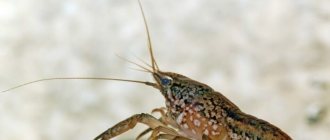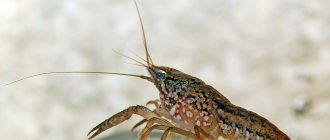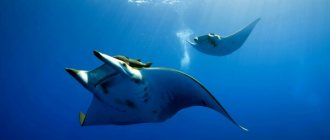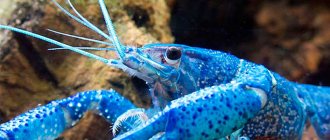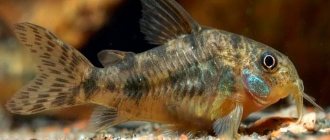Pacu fish, herbivorous piranha, is a freshwater fish of the piranha family. In nature, they are found in the Amazon and Orinoco, standing and flowing reservoirs of their basins.
It has been present in the European classification since the beginning of the 19th century.
Fish farming and fishing facility. Kept in aquariums. They are also found in natural reservoirs of North America and Asia, where they are considered harmful fish, displacing natives. They are bred in nurseries all over the world.
The pacu fish is a conditional herbivore. Juveniles feed on small crustaceans, gastropods and insects washed into the water by rain. The adult prefers plant foods. They can crush nuts.
Natural enemies are local dolphins and crocodiles.
Description
Representatives of piranha pacu are similar in physique and lifestyle.
Appearance
The body shape is an ellipse, laterally compressed to a disk. The anal and dorsal fins are quadrangular, tapering towards the tail. The anal is extended to the tail. The caudal fin is forked. The scales are small, with a silvery sheen.
The eyes are large and mobile. The mouth is large and oriented forward.
The teeth are quadrangular, similar in structure to human molars.
Behavior
- They keep to themselves in the aquarium. They form pairs during spawning.
- They are leisurely, but are active during feeding.
- They eat plants, including hard-leaved plants.
- They do not exhibit any predatory habits, but they will swallow an unwary fish.
- Shy, afraid of sudden movements and loud sounds.
Lifespan
The oldest caught in nature is 28 years old. In captivity - 12–15 years.
Differences between piranha pacu and red piranha
- The color is similar to the smallest detail.
- The teeth of a predatory piranha resemble the points of a pike in appearance. The peculiarity of the bite is externally expressed in the characteristically protruding lower jaw.
- The red pacu piranha is twice the size. A one-year-old pacu corresponds to the size of an adult predatory piranha.
- Red piranha is a pronounced schooling fish.
Fish with human teeth
Pacu is a freshwater fish that originally lived in the rivers of the Amazon and Orinoco basins. Unlike the notorious predators - piranhas - the red pacu has a tooth structure similar to that of humans. They are also adapted for eating plant foods; even the shells of nuts lend themselves to the powerful jaws of the pack. However, cases of injury to people by this fish are not uncommon.
In the wild nature of the Amazon, the fish “fat” up to 30-40 kg of live weight, reaching a meter or more in length. Naturally, a bite from such a “monster” is fraught with consequences, including traumatic amputation.
The lack of control over fish farming has led to the fact that various types of piranhas have colonized the freshwater bodies of other continents. Nowadays you can find her:
- On the islands of the Caribbean.
- In rivers and lakes of North America.
- In Europe.
- On the islands of the Pacific region.
The red pacu has a tooth structure similar to that of a human.
Irresponsible aquarium owners release their pets into the nearest body of water, and if the pacu manages to acclimatize, then it occupies its niche, displacing local species.
After cases of attacks by “vegetarian” predators on swimmers became known, the authorities of some cities banned swimming in reservoirs where this fish was spotted. And on the island of New Guinea, where the pacu, having settled in, feels “at home,” it has become a serious threat to local fishermen. Among the Papuans, this species was called “ball katu,” which translated means “cutting off the genitals.”
When purchasing such an exotic and dangerous inhabitant of a home aquarium as a red pacu, the maintenance of which requires considerable experience and skill, you should critically evaluate your capabilities so that instead of a cute curiosity you do not end up with a dangerous neighbor.
Kinds
Red pacu and black pacu are common in aquariums.
Black pacu
Aka brown pacu (Colossoma nigripinne, Piaractus macropomum). The name "Piaractus macropomus" is incorrect. The abundance of Latin names is explained by the separation of the previously brown pacu into a separate species.
The dominant color is from gray to black. The abdomen is light. In some cases, the anterior part of the abdomen and lower jaw have a pink tint.
The maximum body length in nature is up to 1.08 m with a weight of 40 kg. The typical size is 70 cm. It does not grow like that in an aquarium. Depends on the volume of the vessel.
Red
Called Piaractus brachypomum, red-bellied pacu or two-toothed colossoma (Colossoma bidens).
The dominant color is darker. Caudal fin with a vertical dark stripe. The bottom of the gill covers, lower jaw and abdomen are red/orange. The pectoral and anal fins are red/orange.
The largest specimen captured was 0.88 m in length. Weight - 25 kg.
Breeding
Paku fish reach sexual maturity after 2 years of their life. It is much more difficult for them to reproduce in aquarium conditions than in the natural environment. There are no specific recommendations on how to increase fertility in an aquarium, but experienced aquarists have identified several points that can stimulate fish.
The breeding process will not be simple and quick, but you need to follow a few simple rules in order for them to actually produce offspring. Among them:
- large aquarium volume;
- varied and balanced diet;
- There should be more males in the aquarium than females.
The volume of the spawning tank must be at least 300 liters. Before transplanting the parents there, the spawning tank is thoroughly disinfected. Spawning can also be stimulated with special gopophyseal injections, after which the stimulated fish need to be fed generously. It is ideal to add food of animal origin to your diet. The fish are placed in the spawning tank as soon as they are ready to mate. Once the females have completed the spawning process and the males have fertilized her, the adults can be transplanted back into the aquarium.
The fry will develop fully and actively only with plenty of nutrition. It is also important to separate larger fry from smaller ones as they may eat them. People who decide to have a Paku are satisfied. The fish is unpretentious and easy to care for, but requires a lot of space and costs. Therefore, before purchasing such a fish, you need to weigh all the points so that it lives comfortably and for a long time in the aquarium. We should also not forget that Pacu can only live in small flocks; of all the fry, only the most persistent and healthy ones will survive. If the aquarium remains old and the fry are added there, there may not be enough space for everyone.
Content
The main problem of keeping is the size of the aquarium fish. Adapts to changing conditions. Resistant to diseases.
The conditions for keeping black and red pacu are similar.
Currents in the aquarium are welcome.
Piranha is a timid and nervous fish. Feels confident in the company of 3-4 relatives.
Aquarium for piranha
For an adult, a capacity of 1.5 cubic meters is required. The approximate size of the aquarium (WxHxD) is 2000 x 750 x 1000 mm. In a species aquarium - from 0.8 m3 per individual.
For soil, use pebbles with 1–2 cm fragments or a sandy substrate. The paku fish looks harmonious against a light background.
He eats live plants, but tries artificial and fixed ones. Hang driftwood, massive stones, and rocks as shelters.
Water parameters
- Temperature: 24–27 °C. You will need a heater with a thermostat with a power of 1 W per 1 liter of capacity.
- Hardness: 1–5 °F.
- Acidity: pH 5–7.5.
Interesting Facts
Some of them:
- In New Guinea in 1994, fishermen were attacked and killed. The cause was terrible wounds inflicted by an unknown creature, as a result of which people bled to death. The culprit was a huge killer Pacu, which the famous fisherman Jeremy Wade later managed to catch.
- For breeding as a commercial species, they were launched in the Sipik (1994) and Ramu (1997) rivers. Here they sometimes began to feed on small crocodiles and attack people.
- The largest individuals are found in Papua New Guinea.
- They became notorious as "egg eaters" after male swimmers lost their genitals in an attack (2001).
- The meat may taste like a hybrid striped bass, rainbow trout or tilapia, but will be better than catfish. The meat is soft and sweetish.
Reproduction
Sexual dimorphism is weakly expressed. Females are larger in size, with a swollen abdomen.
Breeding in captivity is problematic. Young individuals are supplied to stores from nurseries.
Hormonal injections are used for spawning. The parents do not care about the eggs; they eat the fry.
The fry need constant sorting. Developed individuals are prone to cannibalism. They are fed daphnia and artemia. Plant food - phytoplankton, large algae. In nurseries they provide artificial food.
Sexual maturity is reached at 12–20 months.
Feeding
The diet should be balanced.
The basis is vegetarian food: lettuce, various grains, chopped fruits and vegetables (pumpkin, cabbage, tomatoes, etc.), grapes, you can use bananas or other tropical fruits that grow in the natural habitat.
You also need to feed organic food: bloodworms (preferably large ones), insect larvae, snails, worms, crustaceans. You can feed fish fry and raw meat, but use it with caution so as not to cause aggressiveness. The most important thing is that there should be a lot of food. They usually feed once during the day so as not to overfeed and increase waste. Proper nutrition helps strengthen the immune system and increase life expectancy.
Photo gallery
What to feed
In nature, the black pacu feeds on small invertebrates and fish, fruits, aquatic plants, nuts, seeds and grains. The aquarium will be happy to eat dry food of the appropriate size, for example, Tetra Cichlid XL Sticks, Tetra Cichlid Algae. Food is taken from the surface and in the water column. Plant foods must be alternated with protein foods. Feed your pets with lettuce, spinach, pieces of cucumber, and zucchini.
An impressive 35kg black pacu caught in Lake Corrego das Antas by Marcio David
Metynnis argenteus, Ahl, 1923.
Metinnis silver photo
A small variety of Piranha. It has a silver-gray body color with chaotically scattered dark warts. The anal fin of the male is veiled, while that of the female is straight and reddish.
Synonyms: silver dollar fish.
Body length: from 10 to 14 cm.
Water parameters: t from 22 to 27 0C, dKH < 1°, dGH up to 5°, pH from 6.5 to 7.0.
Food: omnivore.
Habitat: rivers of the Orinoco and Amazon basins.
Common Metynnis (Metynnis hypsauchen) Müller Troschel.
A small variety of piranha. It has a silver body color with a white belly and transparent fins. The back of Metinnison vulgaris can have a grayish-blue, brown or green tint. The scales have a blue, yellow or greenish tint. The end of the anal fin is red. The body of the fish is high and round, strongly flattened on the sides. There may be black transverse stripes and spots along the sides.
Genera and species of the piranha family in alphabetical order:
Show/Hide text
Acnodon (Eigenmann, 1903): Acnodon normani (Gosline, 1951), Acnodon oligacanthus (Müller & Troschel, 1844), Acnodon senai (Jégu & Santos, 1990).
Catoprion (Müller et Troschel, 1844): Catoprion mento (Cuvier, 1819), Colossoma (Eigenmann et Kennedy, 1903), Colossoma macropomum (Cuvier, 1816).
Metynnis (Cope, 1878): Metynnis altidorsalis (Ahl, 1923), Metynnis argenteus (Ahl, 1923), Metynnis cuiaba (Pavanelli, Ota & Petry, 2009), Metynnis fasciatus (Ahl, 1931), Metynnis guaporensis (Eigenmann, 1915) , Metynnis hypsauchen (Müller & Troschel, 1844), Metynnis lippincottianus (Cope, 1870), Metynnis longipinnis (Zarske & Géry, 2008), Metynnis luna (Cope, 1878), Metynnis maculatus (Kner, 1858), Metynnis mola (Eigenmann & Kennedy, 1903), Metynnis orinocensis (Steindachner, 1908), Metynnis otuquensis (Ahl, 1923), Metynnis polystictus (Zarske & Géry, 2008).
Piranha photo
Mylesinus (Cuvier et Valenciennes, 1849): Mylesinus paraschomburgkii (Jégu, Santos & Ferreira, 1989), Mylesinus paucisquamatus (Jégu & Santos, 1988), Mylesinus schomburgkii (Valenciennes, 1850).
Myleus (Müller et Troschel, 1844): Myleus altipinnis (Valenciennes, 1850), Myleus knerii (Steindachner, 1881), Myleus latus (Jardine, 1841), Myleus micans (Lütken, 1875), Myleus pacu (Jardine, 1841), Myleus setiger (Müller & Troschel, 1844).
Myloplus (Gill, 1896): Myloplus arnoldi (Ahl, 1936), Myloplus asterias (Müller & Troschel, 1844), Myloplus laevis (Eigenmann & McAtee, 1907), Myloplus lobatus (Valenciennes, 1850), Myloplus lucienae (Andrade, Ota, Bastos & Jégu, 2016), Myloplus planquettei (Jégu, Keith & Le Bail, 2003), Myloplus rhomboidalis (Cuvier, 1818), Myloplus rubripinnis (Müller & Troschel, 1844), Myloplus schomburgkii (Jardine, 1841), Myloplus ternetzi (Norman , 1929), Myloplus tiete (Eigenmann & Norris, 1900), Myloplus torquatus (Kner, 1858), Myloplus zorroi (Andrade, Jégu & Giarrizzo, 2016).
Piranha photo
Mylossoma (Eigenmann et Kennedy, 1903): Mylossoma acanthogaster (Valenciennes, 1850), Mylossoma aureum (Spix & Agassiz, 1829), Mylossoma duriventre (Cuvier, 1818).
Ossubtus (Jégu, 1992): Ossubtus xinguense (Jégu, 1992).
Piaractus (Eigenmann, 1903): Piaractus brachypomus (Cuvier, 1818), Piaractus mesopotamicus (Holmberg, 1887).
Pristobrycon (Eigenmann, 1915): Pristobrycon aureus (Spix & Agassiz, 1829), Pristobrycon calmoni (Steindachner, 1908), Pristobrycon careospinus (Fink & Machado-Allison, 1992), Pristobrycon maculipinnis (Fink & Machado-Allison, 1992), Pristobrycon striolatus (Steindachner, 1908).
Piranha teeth mouth photo
Pygocentrus (Müller et Troschel, 1844): Pygocentrus cariba (Humboldt, 1821), Pygocentrus nattereri (Kner, 1858), Pygocentrus palometa (Valenciennes, 1850), Pygocentrus piraya (Cuvier, 1819).
Pygopristis (JP Müller & Troschel, 1844): Pygopristis denticulata (Cuvier, 1819).
Piranha photo
Serrasalmus (Lacepède, 1803): Serrasalmus altispinis (Merckx, Jégu & Santos, 2000), Serrasalmus Altuvei (Ramírez, 1965), Serrasalmus auriventris (Burmeister, 1861), SERRASALMUS Branmus Bran DTII (Lütken, 1875), Serrasalmus Compressus (Jégu, Lege & Santos, 1991), Serrasalmus eigenmanni (Norman, 1929), Serrasalmus elongatus (Kner, 1858), Serrasalmus emarginatus (Jardine, 1841), Serrasalmus geryi (Jégu & Santos, 1988), Serrasalmus gibbus (Castelnau, 1855), Serrasalmus gouldingi ( Fink & Machado-Allison, 1992), Serrasalmus hastatus (Fink & Machado-Allison, 2001), Serrasalmus hollandi (Eigenmann, 1915), Serrasalmus humeralis (Valenciennes, 1850), Serrasalmus irritans (Peters, 1877), Serrasalmus maculatus (Kner, 1858), Serrasalmus manueli (Fernández-Yépez & Ramírez, 1967), Serrasalmus marginatus (Valenciennes, 1837), Serrasalmus medinai (Ramírez, 1965), Serrasalmus nalseni (Fernández-Yépez, 1969), Serrasalmus neveriensis (Machado-Allison, Fink , López Rojas & Rodenas, 1993), Serrasalmus nigricans (Spix & Agassiz, 1829), Serrasalmus nigricauda (Burmeister, 1861), Serrasalmus odyssei (Hubert & Renno, 2010), Serrasalmus rhombeus (Linnaeus, 1766), Serrasalmus sanchezi (Géry, 1966) 4 ), Serrasalmus scotopterus (Jardine, 1841), Serrasalmus serrulatus (Valenciennes, 1850), Serrasalmus spilopleura (Kner, 1858), Serrasalmus stagnatilis (Jardine, 1841), Serrasalmus undulatus (Jardine, 1841).
Tometes (Cuvier et Valenciennes, 1849): Tometes ancylorhynchus (Andrade, Jégu & Giarrizzo, 2016), Tometes camunani (Andrade, Giarrizzo & Jégu, 2013), Tometes kranponhah (Andrade, Jégu & Giarrizzo, 2016), Tometes lebaili (Jégu, Keith & Belmont-Jégu, 2002), Tometes makue (Jégu, Santos & Belmont-Jégu, 2002), Tometes trilobatus (Valenciennes, 1850).
Utiaritichthys (Miranda Ribeiro, 1937): Utiaritichthys esguiceroi (Pereira & Castro, 2014), Utiaritichthys longidorsalis (Jégu, Tito de Morais & Santos, 1992), Utiaritichthys sennaebragai (Miranda Ribeiro, 1937)


